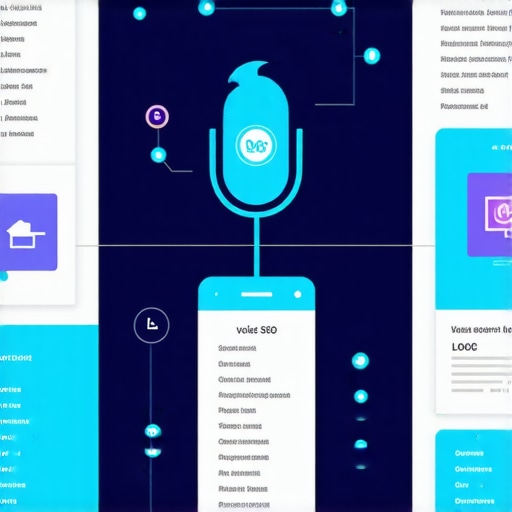Unlocking the Full Potential of Google Maps SEO in 2024: A Strategic Overview
In the rapidly evolving landscape of local search, achieving top rankings on Google Maps and enhancing overall search visibility requires a nuanced understanding of the complex algorithms and user behavior patterns. As an experienced digital strategist, I emphasize that mastering Maps SEO in 2024 involves leveraging a layered approach that integrates technical precision, authoritative content, and user-centric optimization. This comprehensive guide explores innovative techniques to propel your Google visibility to new heights, grounded in proven methodologies and emerging trends.
How Does Google’s Local Algorithm Differ from Traditional Search Algorithms?
Google’s local algorithm prioritizes proximity, relevance, and prominence, making it distinct from traditional SEO. It factors in local citations, NAP consistency, review signals, and engagement metrics. Understanding these variables allows for a sophisticated optimization strategy that aligns with Google’s intent to serve highly relevant local results. Incorporating structured data, such as LocalBusiness schema, enhances the algorithm’s understanding of your offerings, thereby boosting your Maps SEO performance.
What Are the Critical Factors That Influence Google Maps Rankings in 2024?
Key factors include Google My Business (GMB) optimization, citation consistency, review management, and local keyword targeting. Regularly updating your GMB profile with accurate information, engaging with customer reviews, and utilizing geo-specific keywords embedded naturally into your content are essential. Additionally, leveraging effective Maps SEO techniques can significantly influence your rankings.
How Can Businesses Overcome the Challenges of Local Search Competition?
Competing in saturated local markets demands innovative tactics such as hyper-local content creation, strategic backlink building, and leveraging user-generated content. Employing advanced analytics to monitor keyword performance and user engagement allows for continuous refinement. Moreover, integrating voice search optimization and mobile-first strategies ensures visibility across diverse user devices and search modalities.
For a detailed exploration of these strategies, visit our comprehensive Maps SEO guide. Engaging with industry forums and sharing insights can also foster community-driven improvements and innovative ideas.
As Google continues to refine its algorithms, staying ahead requires a commitment to data-driven decision-making and adopting emerging SEO technologies. For further insights, consult authoritative sources like Google’s own Search Central Blog.
Are your current Maps SEO tactics aligned with the latest algorithm updates? Explore our advanced strategies to ensure your local search dominance in 2024 and beyond.
Are You Leveraging Next-Generation Maps SEO Techniques to Outperform Competitors?
In the evolving landscape of local search, staying ahead means continuously refining your approach with cutting-edge strategies rooted in deep algorithm understanding. A key area often overlooked is the integration of AI-driven local data analytics that can uncover hidden opportunities for your business. By harnessing tools such as Google’s own Search Central Blog, SEO practitioners can decode subtle ranking factors that influence Maps visibility in 2024. For example, analyzing user engagement metrics at a granular level enables hyper-targeted optimizations that resonate with local search intent.
How Can Advanced Data Analytics Transform Your Maps SEO Strategy?
Employing sophisticated analytics platforms allows businesses to identify emerging local trends, review sentiment shifts, and optimize content with real-time data insights. This proactive approach ensures your Google My Business (GMB) profile adapts swiftly to algorithm changes, maintaining or improving your position. For instance, integrating AI-powered review analysis can help you craft targeted responses that boost engagement and credibility, directly impacting your rankings. Furthermore, leveraging structured data like LocalBusiness schema in combination with dynamic content updates can significantly enhance your local relevance.
Additionally, adopting a holistic approach that combines effective Maps SEO techniques and voice search optimization can elevate your visibility across diverse search modalities. This multi-pronged strategy responds to the growing influence of voice queries and mobile-first searches, ensuring your business remains prominent in all relevant local searches.
What Are the Practical Implications of Google’s Algorithm Evolution for Local Marketers?
Google’s continuous algorithm updates emphasize the importance of authentic, user-centric content and seamless mobile experiences. For local marketers, this means prioritizing local content creation that addresses specific community needs, leveraging user-generated content, and maintaining consistent NAP data across all platforms. The emphasis on user engagement metrics suggests that fostering a loyal customer base through loyalty programs, reviews, and social proof can translate into tangible ranking gains.
In practice, this involves regularly auditing your local citations, engaging actively with your reviews, and optimizing your website’s local SEO elements. Implementing a comprehensive local SEO audit process, guided by expert frameworks like those outlined in top maps SEO strategies, ensures your efforts align with the latest best practices. Staying informed about algorithm nuances empowers you to adapt swiftly, avoiding common pitfalls that can undermine your local search performance.
For those eager to deepen their understanding, exploring authoritative sources like Google’s Search Central Blog offers invaluable insights into upcoming updates and technical best practices.
Share your experiences or ask questions in the comments—what innovative local SEO tactics have you found most effective in 2024? For more expert guidance, consider delving into our detailed Maps SEO best practices and elevate your local search game today.
Harnessing the Power of Advanced Local Data Analytics for Superior Maps SEO Outcomes
In the quest for local search dominance, leveraging sophisticated data analytics tools transcends basic keyword tracking. Modern SEO practitioners are now integrating AI-driven analytics platforms like Semrush and Ahrefs to uncover nuanced local trends, competitor weaknesses, and emerging user behavior patterns. These insights enable hyper-targeted content strategies and precise optimization efforts that align with evolving Google algorithms.
For example, deploying sentiment analysis on local reviews can reveal underlying customer perceptions that influence engagement. This detailed understanding allows businesses to tailor their responses and service offerings, fostering higher review scores and increased prominence on Google Maps. Additionally, real-time monitoring of local search fluctuations helps in dynamically adjusting your local SEO tactics, ensuring sustained visibility amid a competitive landscape.
What are the technical prerequisites for integrating AI-powered local data analytics into your Maps SEO strategy?
Implementing these advanced analytics requires a robust data infrastructure: integration of structured data (Schema.org), API access to platform-specific insights, and a commitment to continuous data collection. Furthermore, aligning analytics outputs with your local SEO initiatives involves setting up custom dashboards and establishing key performance indicators (KPIs) that reflect local engagement metrics, review sentiment, and citation health. Utilizing these tools effectively demands a blend of technical expertise and strategic foresight, often necessitating collaboration with data scientists or SEO specialists well-versed in AI integrations.
By harnessing these capabilities, businesses gain a competitive edge that not only boosts rankings but also deepens customer relationships through data-driven personalization. As Google continues to prioritize user-centric signals, the ability to interpret and act on granular local data becomes an indispensable element of sophisticated Maps SEO strategies.
The Intersection of Voice Search and Local Optimization: Preparing for the Future
The proliferation of voice-enabled devices has transformed local search behaviors, demanding that businesses adapt their SEO tactics accordingly. Voice search queries tend to be conversational and question-based, often incorporating local intent such as “Where can I find the best coffee near me?” Addressing this shift involves optimizing content for natural language, question-based keywords, and featured snippets.
Moreover, understanding the nuances of voice search requires examining how Google interprets intent and contextual signals. This can include leveraging tools like Google’s Assistant Developer Platform to analyze voice query patterns and tailor your content strategy. Additionally, structuring your local content to answer specific questions, using bullet points, Q&A schema, and concise descriptions, enhances your chances of appearing in voice search results.
The integration of voice search optimization into your broader local SEO plan is crucial for maintaining visibility as these technologies become more ingrained in user behavior. Future-proofing your strategy involves not only technical adjustments but also continuous content refinement aligned with evolving voice search trends.

Visualize the integration of AI analytics and voice search optimization in local SEO with a sophisticated infographic showing data flow, key tools, and strategic touchpoints.
Deciphering Google’s Local Algorithm Nuances: Beyond the Basics
In 2024, understanding the intricacies of Google’s local algorithm requires a focus on latent factors such as machine learning-driven relevance signals and the role of semantic search. Google increasingly relies on contextual understanding, integrating user intent, and behavioral data to refine local results. Advanced SEO practitioners utilize tools like Google’s Search Central Blog to stay ahead of these developments, ensuring their strategies are aligned with the latest algorithmic shifts.
Integrating Hyper-Local Content for Hyper-Targeted Engagement
Emerging trends suggest that hyper-localized content—tailored to specific neighborhoods or community events—can dramatically enhance relevance and user engagement. Deploying Geo-fenced content, localized blog posts, and community-driven narratives creates a rich ecosystem that signals authority and relevance to Google Maps. This approach fosters trust and encourages organic reviews, further elevating your local prominence.
How Can Businesses Exploit AI and Data Science to Surpass Competitors?
Leveraging AI-powered analytics platforms such as Semrush or Ahrefs allows for deep dives into local market trends, sentiment analysis, and competitor benchmarking. These insights enable hyper-precise optimization—identifying gaps in your local citations, review profiles, and keyword saturation—thereby crafting a data-driven roadmap for outranking competitors in Google Maps.
What are the critical technical prerequisites for integrating AI-driven insights into local SEO workflows?
This involves establishing robust data pipelines, integrating structured data schemas like LocalBusiness schema, and utilizing API integrations for real-time insights. Technical expertise in data engineering and SEO analytics is essential for creating dashboards that track KPIs such as review sentiment, citation health, and engagement metrics, ensuring your local SEO efforts are agile and evidence-based.
Harnessing these advanced tools transforms your local SEO from reactive to proactive, positioning your business at the forefront of Google’s evolving local landscape.
Preparing for the Voice Search Revolution: Strategic Content Optimization
With voice searches becoming more conversational and context-aware, optimizing for natural language is no longer optional. Incorporating FAQs, question-based keywords, and structured data markup—such as Q&A schema—is vital. Moreover, analyzing voice query patterns through Google’s Assistant Developer Platform enables precise tailoring of content to meet user expectations.
This shift demands a reimagining of your content strategy: focus on concise, direct answers, and prioritize featured snippets to capture voice-driven traffic. Future-proofing involves continuous content refinement aligned with emerging voice search trends, ensuring your local visibility remains unchallenged.

Visualize the integration of AI analytics and voice search optimization in local SEO with a sophisticated infographic showing data flow, key tools, and strategic touchpoints.
Expert Insights & Advanced Considerations
1. Integrate AI-Driven Local Data Analytics for Hyper-Targeted Optimization
Leveraging sophisticated AI analytics platforms like Semrush and Ahrefs enables businesses to uncover hidden local trends, review sentiment shifts, and identify emerging user behaviors. This data-driven approach allows for hyper-targeted content creation and precise optimization efforts that align with evolving Google algorithms, ensuring sustained visibility and competitive advantage.
2. Embrace Hyper-Local Content Strategies for Enhanced Relevance
Developing geo-fenced content, community-specific narratives, and localized blog posts signals authority and relevance in targeted neighborhoods. This hyper-local approach fosters trust, encourages organic reviews, and improves rankings on Google Maps by demonstrating genuine community engagement and local expertise.
3. Prioritize Voice Search Optimization for Future-Proofing
As voice-enabled searches grow, optimizing content for natural language, question-based keywords, and featured snippets becomes essential. Using tools like Google’s Assistant Developer Platform to analyze voice query patterns enables businesses to tailor their content and maintain top visibility in voice-driven local searches.
4. Implement Structured Data for Semantic Search Enhancement
Using LocalBusiness schema and Q&A markup enhances Google’s understanding of your content, improving your chances of appearing in rich snippets and voice search results. Continuous technical refinement of structured data ensures your local SEO remains aligned with the latest semantic search advancements.
5. Continuous Monitoring and Agile Adjustment
Employ real-time analytics dashboards to track local engagement, citation health, review sentiment, and keyword performance. This ongoing monitoring facilitates agile adjustments to your strategies, ensuring resilience against algorithm updates and shifting user behaviors.
Curated Expert Resources
- Google Search Central Blog: The authoritative source for official updates, algorithm insights, and technical best practices directly from Google, essential for staying ahead in local SEO.
- Semrush Blog: Offers in-depth guides on AI integration, local data analytics, and competitive benchmarking tailored for advanced SEO practitioners.
- Ahrefs Blog: Known for comprehensive SEO insights, including backlink strategies, content optimization, and local search tactics that are crucial for expert-level optimization.
- Schema.org Documentation: The definitive resource for implementing structured data schemas to enhance semantic understanding and rich snippet eligibility.
- Google Assistant Developer Platform: Provides tools and insights to optimize content for voice search and conversational AI, future-proofing your local SEO efforts.
Final Expert Perspective
Mastering Google Maps SEO in 2024 requires a sophisticated blend of AI-driven analytics, hyper-local content, voice search optimization, and structured data enhancement. These advanced strategies, rooted in authoritative resources and continuous monitoring, position your business at the forefront of local search visibility. For industry leaders and forward-thinking marketers, embracing these insights ensures resilience and dominance amid Google’s evolving algorithms. Engage with these expert strategies, share your insights, or explore further resources to elevate your local SEO mastery—because in the realm of Google Maps, only the prepared thrive.




Benjamin Carter
This post offers a comprehensive overview of how to stay ahead in Google Maps SEO for 2024. I particularly appreciate the emphasis on integrating AI-driven analytics and hyper-local content strategies. From my experience managing local listings, consistently monitoring citation health and review sentiment can make a significant difference. One challenge I’ve faced is maintaining NAP consistency across numerous directories, especially when expanding into new neighborhoods. Has anyone found effective tools or processes to streamline this for larger portfolios? Additionally, I’m curious about how to best leverage structured data in a way that adapts to frequent algorithm updates. Continuous data validation seems essential. Overall, staying agile and utilizing these advanced tools has helped us maintain top rankings, but it’s a constant effort. What strategies do others use for real-time monitoring and quick response to local ranking shifts? Would love to hear insights from those with similar experiences.
Madison Riley
This post really highlights the importance of integrating advanced analytics into local SEO strategies for 2024. I’ve personally seen how leveraging tools like Semrush and Ahrefs to analyze local review sentiment and engagement metrics can be a game-changer. One challenge I’ve encountered is ensuring our structured data and schema markups stay up-to-date with the latest Google updates, which sometimes involves a lot of manual validation. Has anyone discovered reliable automated solutions for continuous structured data validation? Also, hyper-local content targeting has worked well for us in engaging neighborhoods directly, but I wonder if there’s a points of diminishing returns when targeting very small areas. How do others strike a balance between hyper-local content and broader market relevance? This layered approach really seems promising for maintaining visibility amid the constantly evolving local algorithm landscape. Looking forward to hearing strategies that others have found effective for rapid adaptation and sustained engagement in competitive local markets.